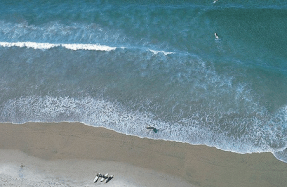A Crossroads for Surfcraft




The province of Nonthaburi, Thailand, lies just north of Bangkok and for many years the area has mostly been known for producing durian, a thorny-rind-covered fruit that tastes very good, but smells so much like rotten garbage that it’s banned from many hotels and forms of public transit across Southeast Asia. In recent decades, commercial sprawl spreading out from Bangkok has crept into Nonthaburi, with condominiums, office towers and industrial parks sprouting everywhere. The city of Nonthaburi, the province’s urban center, is really just a suburb of Bangkok, and home to some 265,000 people living along the winding Chao Phraya River as it snakes its way south, draining into the Bay of Thailand.
Every single day, some of those 265,000 people, who may have once worked harvesting and packaging smelly-but-delicious durian, now head into the city’s industrial park to join a manufacturing assembly line building a product most of the workers know little about, save assembly instructions, and few, if any, will ever use. Those products are some of the world’s most technologically-advanced surfboards, built at Firewire’s Nonthaburi factory.
Firewire’s Thailand plant is a massive, 98,000-square-foot facility composed of two separate buildings that sit some 100 meters apart. Workers, forklifts and loading trucks scramble everywhere. It’s loud. Six huge computer numerical control (CNC) machines constantly whine as they saw their way through expanded polystyrene foam blanks (the kind that looks like Styrofoam) that will eventually become surfboards under the Firewire, Slater Designs, and Tomo Designs labels. There is a separate room for blank production; Firewire doesn’t blow their own foam there but they do insist on assembling the constituent parts of what can sometimes be very complicated and unconventional blanks. Another room houses the machines for vacuum sealing finished boards.
The state-of-the-art factory employs 300 Nonthaburians, and they’d probably be surprised to learn that the surfboards they produce are “Chinese popouts” (“popout,” of course, being the derogatory term for surfboards made in large quantities overseas, mostly through the aid of machines). Or at least they are according to many domestically-produced surfboard supporters in the U.S., disdainful of the mass-produced imports shipped to American surf shops. For American workers
You’re reading a preview, subscribe to read more.
Start your free 30 days





